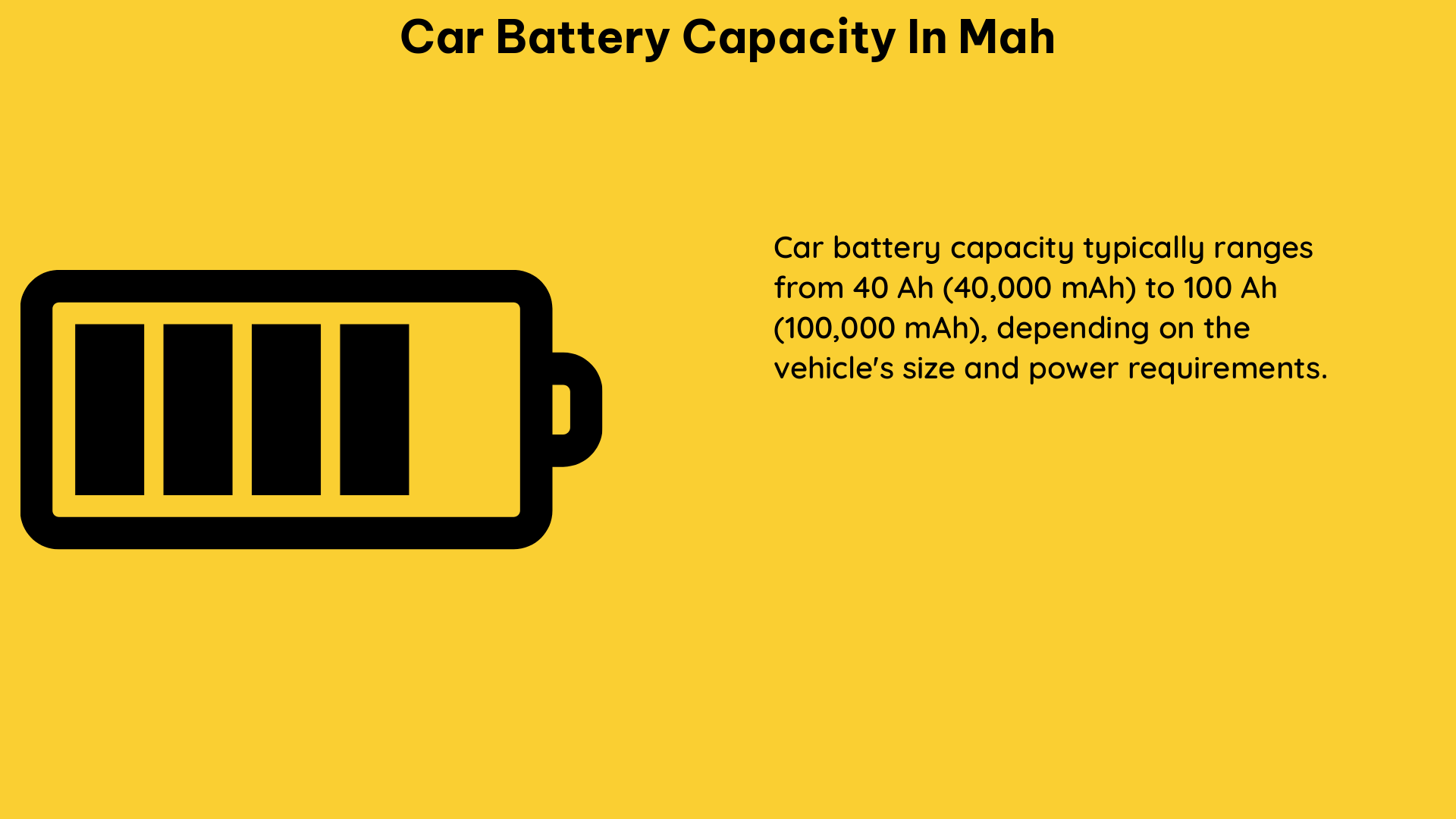Car batteries are the unsung heroes of our vehicles, providing the essential power needed to start the engine and keep the electrical systems running. Understanding the capacity of your car battery, measured in milliampere-hours (mAh), is crucial for ensuring optimal performance and longevity. In this comprehensive guide, we’ll delve into the intricacies of car battery capacity, exploring the factors that influence it, the methods to measure it, and the practical implications for car owners.
Understanding Car Battery Capacity in mAh
Car batteries are typically rated in ampere-hours (Ah), which represents the amount of current the battery can supply for a specific duration. However, to provide a more detailed and precise measurement, the capacity is often expressed in milliampere-hours (mAh), which is a thousand times smaller than Ah.
The capacity of a car battery in mAh is a direct reflection of the battery’s ability to store and deliver electrical energy. This capacity is influenced by various factors, including the battery’s chemistry, size, and construction. A higher mAh rating generally indicates a greater capacity and the ability to power the car’s electrical systems for a more extended period.
Factors Influencing Car Battery Capacity

-
Battery Chemistry: The type of chemical composition used in the battery, such as lead-acid, lithium-ion, or absorbed glass mat (AGM), can significantly impact the battery’s capacity. Lead-acid batteries, the most common type in cars, typically have a capacity range of 40,000 to 80,000 mAh, while lithium-ion and AGM batteries can reach capacities of up to 100,000 mAh or more.
-
Battery Size: The physical size and weight of the battery are directly proportional to its capacity. Larger batteries, often found in larger vehicles, can have capacities ranging from 60,000 to 100,000 mAh, while smaller batteries in compact cars may have capacities between 40,000 to 60,000 mAh.
-
Battery Age and Condition: As a car battery ages, its capacity can gradually decrease due to factors such as sulfation, corrosion, and internal resistance buildup. A well-maintained, newer battery may have a capacity of 80,000 mAh or more, while an older, worn-out battery may have a capacity as low as 40,000 mAh.
-
Temperature: Extreme temperatures, both hot and cold, can affect a car battery’s capacity. High temperatures can accelerate the battery’s self-discharge rate, while low temperatures can reduce the battery’s ability to deliver its full capacity.
-
Usage Patterns: The way a car is driven and the electrical load placed on the battery can also impact its capacity. Frequent short trips, extensive use of accessories, and high-power demands can all contribute to a faster decline in the battery’s capacity over time.
Measuring Car Battery Capacity in mAh
Accurately measuring the capacity of a car battery in mAh requires specialized equipment and a controlled testing environment. Here are the common methods used to determine the mAh capacity:
-
Load Testing: A load tester is connected to the battery, and a constant load is applied while the battery is discharged. The time it takes for the battery to reach a specific voltage threshold is measured, and the capacity is calculated based on the discharge rate and time.
-
Capacity Tester: A dedicated capacity tester is connected to the battery and measures the total amount of current the battery can supply until it reaches a predetermined voltage level. The tester then displays the capacity in mAh.
-
Discharge and Recharge: This method involves fully discharging the battery and then recharging it, measuring the total amount of current (in mAh) required to bring the battery back to a full charge.
-
Manufacturer Specifications: Car battery manufacturers often provide the capacity of their batteries in mAh, which can be used as a reference point. However, it’s important to note that actual capacity may vary due to the factors mentioned earlier.
Practical Implications of Car Battery Capacity in mAh
Understanding the capacity of your car battery in mAh can have several practical implications for car owners:
-
Battery Replacement: Knowing the current capacity of your battery can help you determine when it’s time to replace it, ensuring your car’s electrical system remains reliable and your battery can meet the power demands.
-
Battery Maintenance: Monitoring the battery’s capacity can help you identify any issues, such as sulfation or internal resistance buildup, and take appropriate maintenance actions to prolong its lifespan.
-
Power Consumption Management: Awareness of your battery’s capacity can help you manage the electrical load on the battery, especially when using high-power accessories or making modifications to the car’s electrical system.
-
Battery Selection: When replacing a car battery, knowing the capacity in mAh can assist you in selecting a replacement that matches or exceeds the original battery’s performance, ensuring seamless integration and optimal power delivery.
-
Battery Charging and Maintenance: Understanding the battery’s capacity can guide you in choosing the appropriate charging equipment and techniques, ensuring the battery is charged efficiently and without overcharging, which can damage the battery.
By delving into the intricacies of car battery capacity in mAh, you can make informed decisions, maintain your vehicle’s electrical system, and extend the lifespan of your car’s battery.
References:
- Battery Capacity: Definition, Measurement, and Factors Affecting It
- Factors Affecting the Capacity of Lead-Acid Batteries
- How to Measure the mAh of a Battery
- Understanding Car Battery Capacity and Its Importance
- Measuring and Interpreting Car Battery Capacity

The lambdageeks.com Core SME Team is a group of experienced subject matter experts from diverse scientific and technical fields including Physics, Chemistry, Technology,Electronics & Electrical Engineering, Automotive, Mechanical Engineering. Our team collaborates to create high-quality, well-researched articles on a wide range of science and technology topics for the lambdageeks.com website.
All Our Senior SME are having more than 7 Years of experience in the respective fields . They are either Working Industry Professionals or assocaited With different Universities. Refer Our Authors Page to get to know About our Core SMEs.